By Aaron Earls
LifeWay News Office
NASHVILLE — Churches are gathering again, but services and programs remain drastically different from the beginning of the year.
At the start of the COVID-19 outbreak, according to previous surveys from Nashville-based LifeWay Research, Protestant churches across the U.S. stopped gathering in-person in a matter of weeks.
The latest LifeWay Research survey of Protestant pastors found congregations have slowly and cautiously started to meet again.
“While more and more churches have resumed in-person worship services, it has not always been a straight path back,” said Scott McConnell, executive director LifeWay Research. “Some have had difficulty resuming or had to stop meeting again as things got worse in their area.”
Cautious regathering
Each Sunday in April, fewer than one in 10 Protestant churches held in-person services.
Starting in May, those numbers began to climb. By the first weekend in June, a majority (55 percent) were gathering. In July, more than 7 in 10 have met physically.
Still, 21 percent of Protestant pastors say they have not met in person the past three months.
Around one in 5 churches (21 percent) offered drive-in services where attendees participated from their vehicles at some point during the pandemic.
For those churches choosing to meet physically indoors, 99 percent point to some type of health and safety precaution they are taking.
More than three in four pastors say they provided hand sanitizer, masks or gloves to those needing it (94 percent), conducted additional cleaning of surfaces (86 percent), or closed seats to increase distance between people (76 percent).
Most have recommended masks (59 percent), but only around a third (35 percent) have required attendees to wear them.
Many churches have added services (21 percent) or additional viewing rooms (18 percent,) and conducted temperature checks of staff and volunteers (21 percent ) and all attendees (14 percent).
“Resuming in-person worship services has not been reverting to worship as usual,” McConnell said. “Churches are making efforts to make the environment safe, but these efforts are often second-guessed by those who want more precautions or less restrictions.”
COVID impact
While most Protestant churches still have not seen an attendee be diagnosed with COVID-19, the number of pastors who have is growing.
In March, 5 percent of pastors said one of their attendees had a positive diagnosis. That jumped to 20 percent in April. For May through July, 28 percent of pastors say someone in their church has been diagnosed with COVID-19.
One in 20 Protestant pastors (5 percent) have dealt with an attendee dying from the coronavirus.
In the past three months, pastors say church attendees have also dealt with reduced hours at work (74 percent) and losing a job (48 percent).
More than four in five pastors (83 percent) say new people who have not attended their church in the past have attended or connected online since the pandemic began. And 13 percent say an attendee has seen someone make a commitment to follow Christ after sharing the gospel.
In terms of the offering plate, 34 percent of pastors say they’ve received less in 2020 than at this point in 2019, with 29 percent saying giving has stayed around the same and 28 percent saying it has increased.
Uncertain future
Even though most Protestant churches are gathering, pastors are more hesitant to begin small group Bible studies or activities for children and teenagers.
Close to 3 in 10 pastors (29 percent) say in-person adult Bible studies are currently gathering, including 3 percent who say they never stopped. Almost 1 in 5 (18 percent) plan to restart those groups by September, 7 percent say some time in October through December, and 3 percent say in 2021. For 42 percent of pastors, they have not made that decision yet.
Half of Protestant pastors (51 percent) haven’t decided when to start in-person student ministry activities, while a quarter (23 percent) are meeting now, including 2 percent who say they never stopped. Some have made plans to begin in August (7 percent), September (9 percent), some time in October through December (5 percent), or in 2021 (2 percent).
Pastors are even more hesitant about kids ministry activities. Only 1 percent say they never stopped in-person activities with children, and 12 percent say they have resumed them.
Almost three in five (57 percent) say it is still to be determined when they will start back. Fewer plan to begin in August (6 percent), September (11 percent), sometime in October through December (7 percent), or in 2021 (3 percent).
“Maintaining social distance and necessary sanitation is very difficult with younger ages,” said McConnell. “To complicate things further, some of the volunteers who normally work with kids and students are in higher risk groups who are not ready to return any time soon.”

